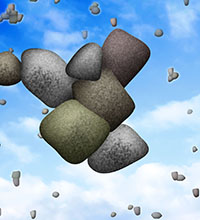Atmospher Sci & Global Chg
Research Highlights
March 2016
An Improved Compact Picture of Particles
New model technique, specific to carbon-containing aerosol particles, sharpens climate model

Carbon-containing atmospheric particles are complex, coming in a variety of shapes, sizes, and compositions.
Results: Two heads are often better than one, and a fourth mode is better than three when it comes to models of complex atmospheric particles.
A team from the University of Wyoming and Pacific Northwest National Laboratory improved a popular atmospheric model by adding a new way to depict carbon-containing atmospheric particles. The improvement accounts for fresh smoke that is composed almost entirely of organic and soot particles. These particles are not washed out from the atmosphere quickly, and may drift through the atmosphere, far from their source before removal. With this in mind, researchers used a new technique to simulate the global distribution of carbon-containing aerosols more realistically. And they did so without adding much time or cost to running the simulations.
Why it Matters: Carbon-containing aerosol particles influence Earth's energy budget. Like all budgets, the give and take between incoming energy from the sun, and outgoing thermal and reflected energy from the Earth, should remain in balance. But there are some forces that constantly push that balance one direction or another. Carbon-containing aerosols come from a variety of sources, most of them the result of burning fossil fuels. They both absorb and scatter the sun's energy, making them a wildcard for researchers studying and measuring the energy balance and the impacts of climate change. Furthermore, they change clouds, impact visibility in the sky, and negatively affect human health.
The challenge is developing a model that's as sophisticated as the particles themselves. They come in a variety of shapes, sizes, and compositions. To represent them in climate models, though, the representations must be simplified. If not, it would take years to run simulations because of the complexity of the information poured into the model. Getting the numbers right is important because as human activities produce more of the carbon-containing particles by burning fossil fuels, measuring the changes in the Earth's energy balance may tip critical.
Methods: A previous minimal representation—that is, a compact picture—of an aerosol's complexity in a community climate model assumed all particles are spheres that come in three sizes, each composed of mixtures of sulfate, organic carbon, black carbon, dust, and sea salt. Unfortunately, this assumption vastly underestimates fresh pure carbon-containing aerosol particle concentrations.
The research team designed a new, fourth mode that represents only organic and black carbon in the model. Because fresh black carbon can age by condensation of sulfuric acid and organic vapors and by coagulation with aged particles, they simulated aerosol concentrations with both the four-mode and old three-mode assumptions and compared them with measurements across the world. Their analyses show that the fourth mode representation increases black carbon concentrations at all altitudes, compared to those concentrations found using only the third mode in the model.
What's Next? Not all carbon-containing aerosol particles are alike. The team is considering distinguishing between organic carbon particles that comes from fires versus the type that is emitted by vehicles. Organic carbon from vehicles is much less soluble than organic carbon in fresh smoke.
Acknowledgments
Sponsor: The Department of Energy's Office of Science, Office of Biological and Environmental Research supported this work for the Earth System Modeling Program.
Research Team: Po-Lun Ma, Hailong Wang, Balwinder Singh, Richard Easter, Steve Ghan and Phil Rasch, PNNL; Xiaohong Liu, University of Wyoming.
Research Area: Climate & Earth Systems Science
Reference: Liu X, P-L Ma, H Wang, S Tilmes, B Singh, R Easter, SJ Ghan, and PJ Rasch. 2016. "Description and Evaluation of a New 4-Mode Version of Modal Aerosol Module (MAM4) within Version 5.3 of the Community Atmosphere Model." Geoscientific Model Development 9: 505-522. DOI: 10.5194/gmd-9-505-2016
Related Highlights: Bytes for Bits
